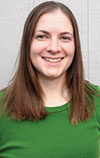The second weekend in June, I spent about four hours talking to consumers at a local Dairy Days event with Midwest Dairy. The goal was to share information about dairy farming and dairy products with consumers in our community. Our booth was frequented by mostly parents with young children.
We had a cutout cow that kids could milk, mason jar butter churns, dairy trivia, a selfie booth, cardboard cow hats to pass out and samples of various feed components. I spent most of my time passing out cow hats and pointing out and discussing the various feed ingredients on the table in front of me.
One thing I learned when I first started doing events like this is if you catch the kids’ interest, you’ve gained an opportunity to grab the parents’ interest by asking the right questions or telling the right facts to the kids. With the feed samples, most parents picked up on the whole corn or made a comment about grass or hay being the "best" feed. I was pleasantly surprised, though, that several people looked at all the samples and focused on the corn silage, often asking, "What is that?"
All three situations were welcome opportunities to explain what silage is and that most of the corn our cows eat looks like that rather than the whole dried corn kernels. I explained the basics of feeding TMR, and I think there was some genuine interest in what our dairy cows are eating and what they gain from each feed component.
Why do I participate in these events?
My main goal is the obvious one – to help put a face to the industry. I want to let our consumers know that milk is sent to the store by members of their community, not some faceless corporation. In the process, I can also attempt to explain the effort and care we put into operating our farms, as well as answer any questions the consumer may have.
I get more than just that out of the events, though. For one, I usually learn something. Teaching something requires you to learn it in a different way. Feed is not my area of expertise, and our farm buys a commodity blend instead of individual commodities, so I actually learned some in this area from some of the other farmers helping with the event. In general, I've also learned a lot more about dairy products, instead of just production, by participating in this and other similar events.
Finally, I enjoy the social aspect of the events. It’s always fun to catch up with other farmers around the region who I rarely see, and I enjoy conversations with consumers that shine some light on their concerns and perceptions.
How can you get involved?
If you've never done an event like this, I would encourage you to contact your local checkoff organization and let them know you're interested. There are a wide variety of opportunities available for farmers to attend events or speak to groups. If you think you aren't qualified, there are possible training opportunities as well, but I think the message is much better received when it’s personal and candid, so there’s no need to rehearse too much. After all, who knows more about dairy farming than you? PD

-
Jennifer Heim
- Dairy Producer and Engineer
- Easton, Kansas
- Email Jennifer Heim






